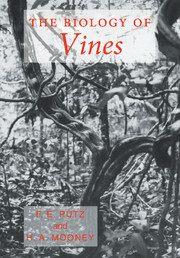Book contents
- Frontmatter
- Contents
- List of contributors
- Foreword
- Preface
- Acknowledgements
- I INTRODUCTION
- II CLIMBING MECHANICS AND STEM FORM
- III VINE PHYSIOLOGY AND DEVELOPMENT
- 5 Water flux and xylem structure in vines
- 6 Reserve economy of vines
- 7 Photosynthesis and gas exchange of vines
- 8 Heteroblastic development in vines
- 9 Physiological ecology of mesic, temperate woody vines
- 10 Secondary compounds in vines with an emphasis on those with defensive functions
- IV COMMUNITY ECOLOGY OF VINES
- V ECONOMIC IMPORTANCE OF VINES
- Taxonomic index
- General index
9 - Physiological ecology of mesic, temperate woody vines
Published online by Cambridge University Press: 05 November 2011
- Frontmatter
- Contents
- List of contributors
- Foreword
- Preface
- Acknowledgements
- I INTRODUCTION
- II CLIMBING MECHANICS AND STEM FORM
- III VINE PHYSIOLOGY AND DEVELOPMENT
- 5 Water flux and xylem structure in vines
- 6 Reserve economy of vines
- 7 Photosynthesis and gas exchange of vines
- 8 Heteroblastic development in vines
- 9 Physiological ecology of mesic, temperate woody vines
- 10 Secondary compounds in vines with an emphasis on those with defensive functions
- IV COMMUNITY ECOLOGY OF VINES
- V ECONOMIC IMPORTANCE OF VINES
- Taxonomic index
- General index
Summary
Introduction
Distribution, diversity and abundance
In North America, woody vines (lianas) of mesic, temperate environments can be found across a wide range of physiognomic regions, from open fields to climax hardwood forests. Within this range, lianas are predominantly associated with the arborescent vegetation of mid- to late-successional sites in eastern deciduous forests. The deciduous forest of eastern North America exhibits a pronounced gradient from south to north of decreasing mean daily temperature and length of growing season, while there is an east-to-west gradient of decreasing precipitation and increasing temperature variation (Figure 9.1). Within these gradients, lianas appear to be most abundant in the southeastern (warmest, highest precipitation) portion of the biome.
The woody vines native to the eastern deciduous forests are taxonomically diverse (Braun, 1950). Duncan (1975) lists a total of 30 genera in 21 families occurring in the southeastern USA (Table 9.1). This diversity for temperate vines is much less than that for vines of tropical ecosystems (Putz, 1984; Putz & Chai, 1987). The pattern of localized dominance for lianas in eastern North America has dramatically changed over the last 100 years with the rapid spread of exotic species such as Lonicera japonica Thunb., Pueraria lobata (Willd.) Owhi, and Celastrus orbiculatus Thunb. (Sasek, 1985; McNab & Meeker, 1987; Patterson, 1973; Wechsler, 1977) and with increasing disturbance resulting from human activities.
The proliferation of vines in a temperate forest involves a variety of factors, many of which are probably species-specific.
- Type
- Chapter
- Information
- The Biology of Vines , pp. 245 - 286Publisher: Cambridge University PressPrint publication year: 1992
- 6
- Cited by

